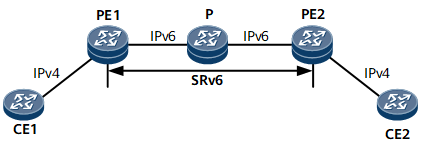Configuring L3VPNv4 over SRv6 BE
This section describes how to configure L3VPNv4 over SRv6 BE.
Usage Scenario
L3VPNv4 over SRv6 BE allows SRv6 BE paths on public networks to carry L3VPNv4 data. The implementation of L3VPNv4 over SRv6 BE involves establishing SRv6 BE paths, advertising VPN routes, and forwarding data.
As shown in Figure 1, PE1 and PE2 communicate through an IPv6 public network. The VPN is a traditional IPv4 network. SRv6 BE paths can be deployed on the IPv6 public network to carry L3VPNv4 services on the VPN.
Pre-configuration Tasks
Before configuring L3VPNv4 over SRv6 BE, complete the following tasks:
Configure a link layer protocol.
Configure network-layer addresses for interfaces to ensure that neighboring devices are reachable at the network layer.
Procedure
- Configure IPv6 IS-IS on each PE and P. For configuration details, see Configuring Basic IPv6 IS-IS Functions.
- Configure a VPN instance on each PE and enable the IPv4 address family for the instance.
- Configure IPv4 route exchange between the PE and CE. For configuration details, see Configuring Route Exchange Between PEs and CEs.
- Establish an MP-IBGP peer relationship between the PEs.
- Configure basic SRv6 functions.
- Enable IS-IS SRv6 on PEs.
- Configure VPN routes on PEs to carry SIDs and recurse to SRv6 BE paths based on the SIDs.
Verifying the Configuration
After configuring L3VPNv4 over SRv6 BE, verify the configuration.
Run the display segment-routing ipv6 locator [ locator-name ] verbose command to check SRv6 locator information.
Run the display segment-routing ipv6 local-sid { end | end-x | end-dt4 } [ sid ] forwarding command to check information about the SRv6 local SID table.
Run the display bgp vpnv4 { all | route-distinguisher route-distinguisher | vpn-instance vpn-instance-name } routing-table [ network [ prefix-length ] ] command to check BGP VPNv4 route information.
Run the ping command to check the connectivity between CEs.

